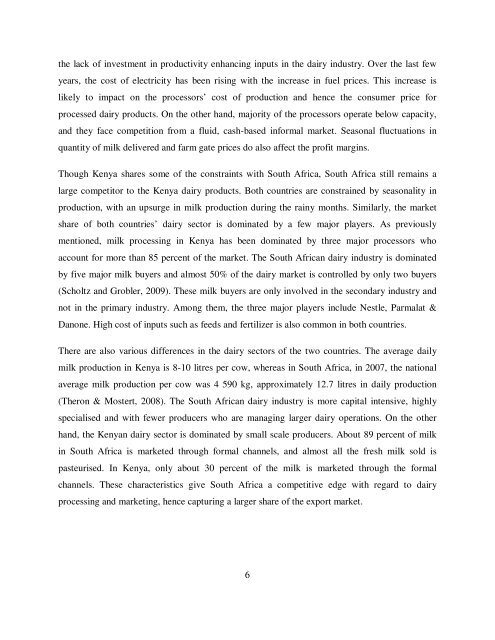WP43-Productivity-Trends-and-Performance-of-Dairy-Farming-in-Kenya
WP43-Productivity-Trends-and-Performance-of-Dairy-Farming-in-Kenya
WP43-Productivity-Trends-and-Performance-of-Dairy-Farming-in-Kenya
Create successful ePaper yourself
Turn your PDF publications into a flip-book with our unique Google optimized e-Paper software.
the lack <strong>of</strong> <strong>in</strong>vestment <strong>in</strong> productivity enhanc<strong>in</strong>g <strong>in</strong>puts <strong>in</strong> the dairy <strong>in</strong>dustry. Over the last few<br />
years, the cost <strong>of</strong> electricity has been ris<strong>in</strong>g with the <strong>in</strong>crease <strong>in</strong> fuel prices. This <strong>in</strong>crease is<br />
likely to impact on the processors’ cost <strong>of</strong> production <strong>and</strong> hence the consumer price for<br />
processed dairy products. On the other h<strong>and</strong>, majority <strong>of</strong> the processors operate below capacity,<br />
<strong>and</strong> they face competition from a fluid, cash-based <strong>in</strong>formal market. Seasonal fluctuations <strong>in</strong><br />
quantity <strong>of</strong> milk delivered <strong>and</strong> farm gate prices do also affect the pr<strong>of</strong>it marg<strong>in</strong>s.<br />
Though <strong>Kenya</strong> shares some <strong>of</strong> the constra<strong>in</strong>ts with South Africa, South Africa still rema<strong>in</strong>s a<br />
large competitor to the <strong>Kenya</strong> dairy products. Both countries are constra<strong>in</strong>ed by seasonality <strong>in</strong><br />
production, with an upsurge <strong>in</strong> milk production dur<strong>in</strong>g the ra<strong>in</strong>y months. Similarly, the market<br />
share <strong>of</strong> both countries’ dairy sector is dom<strong>in</strong>ated by a few major players. As previously<br />
mentioned, milk process<strong>in</strong>g <strong>in</strong> <strong>Kenya</strong> has been dom<strong>in</strong>ated by three major processors who<br />
account for more than 85 percent <strong>of</strong> the market. The South African dairy <strong>in</strong>dustry is dom<strong>in</strong>ated<br />
by five major milk buyers <strong>and</strong> almost 50% <strong>of</strong> the dairy market is controlled by only two buyers<br />
(Scholtz <strong>and</strong> Grobler, 2009). These milk buyers are only <strong>in</strong>volved <strong>in</strong> the secondary <strong>in</strong>dustry <strong>and</strong><br />
not <strong>in</strong> the primary <strong>in</strong>dustry. Among them, the three major players <strong>in</strong>clude Nestle, Parmalat &<br />
Danone. High cost <strong>of</strong> <strong>in</strong>puts such as feeds <strong>and</strong> fertilizer is also common <strong>in</strong> both countries.<br />
There are also various differences <strong>in</strong> the dairy sectors <strong>of</strong> the two countries. The average daily<br />
milk production <strong>in</strong> <strong>Kenya</strong> is 8-10 litres per cow, whereas <strong>in</strong> South Africa, <strong>in</strong> 2007, the national<br />
average milk production per cow was 4 590 kg, approximately 12.7 litres <strong>in</strong> daily production<br />
(Theron & Mostert, 2008). The South African dairy <strong>in</strong>dustry is more capital <strong>in</strong>tensive, highly<br />
specialised <strong>and</strong> with fewer producers who are manag<strong>in</strong>g larger dairy operations. On the other<br />
h<strong>and</strong>, the <strong>Kenya</strong>n dairy sector is dom<strong>in</strong>ated by small scale producers. About 89 percent <strong>of</strong> milk<br />
<strong>in</strong> South Africa is marketed through formal channels, <strong>and</strong> almost all the fresh milk sold is<br />
pasteurised. In <strong>Kenya</strong>, only about 30 percent <strong>of</strong> the milk is marketed through the formal<br />
channels. These characteristics give South Africa a competitive edge with regard to dairy<br />
process<strong>in</strong>g <strong>and</strong> market<strong>in</strong>g, hence captur<strong>in</strong>g a larger share <strong>of</strong> the export market.<br />
6


